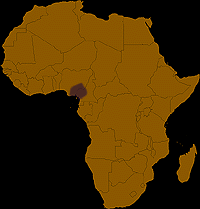
 |
Major river systems, such as the Niger and Cross rivers, and innumerable smaller waterways traverse this region. The people live in autonomous villages governed by men's associations. The visual arts of the area, including masks, headdresses, and figures, reveal a considerable interchange between groups. Strong stylistic affinities exist, for example, between the art of the Igbo, who are the most numerous peoples in the region, and that of their neighbors. A wide variety of Igbo carving traditions are characterized by bold and intricate forms as well as richly colored surfaces.
A corpus of copper-alloy objects, attributed to the "Lower Niger Bronze Industry," has been found in this region. The origin, date, and use of the objects are unknown. Other cast copper-alloy objects, as well as fired-clay objects, have been found in Igbo-Ukwu, an archaeological site that is dated from the 9th to the 10th century.
|